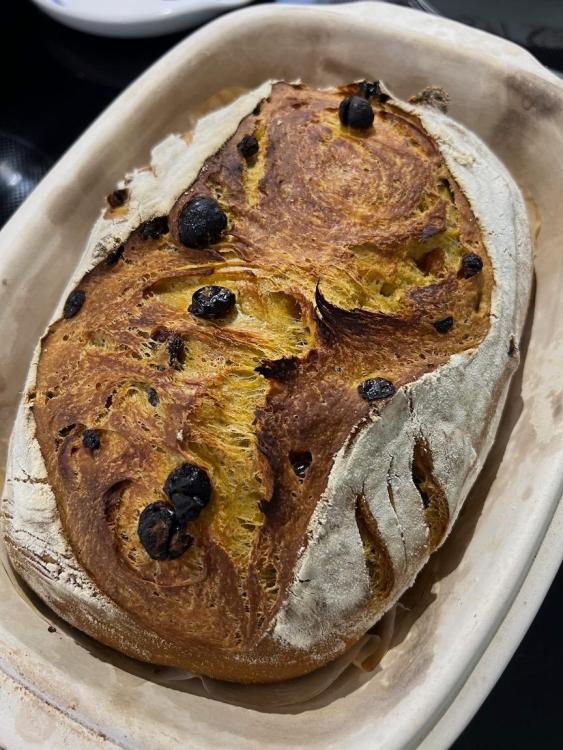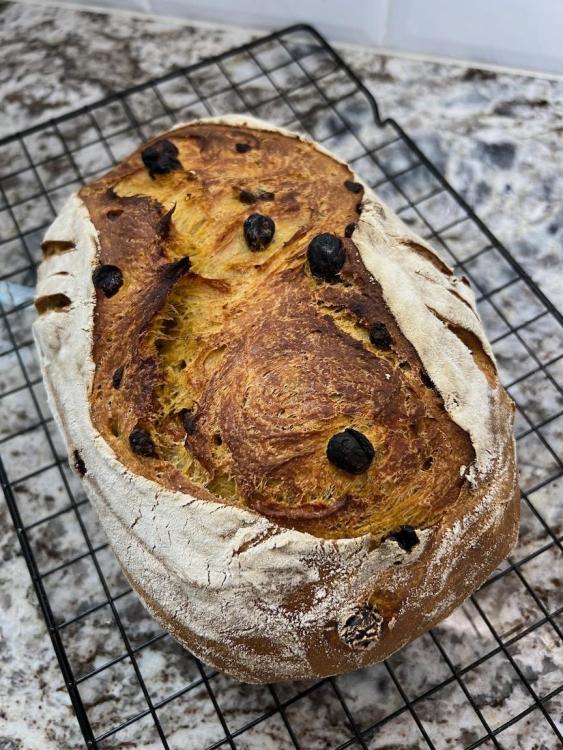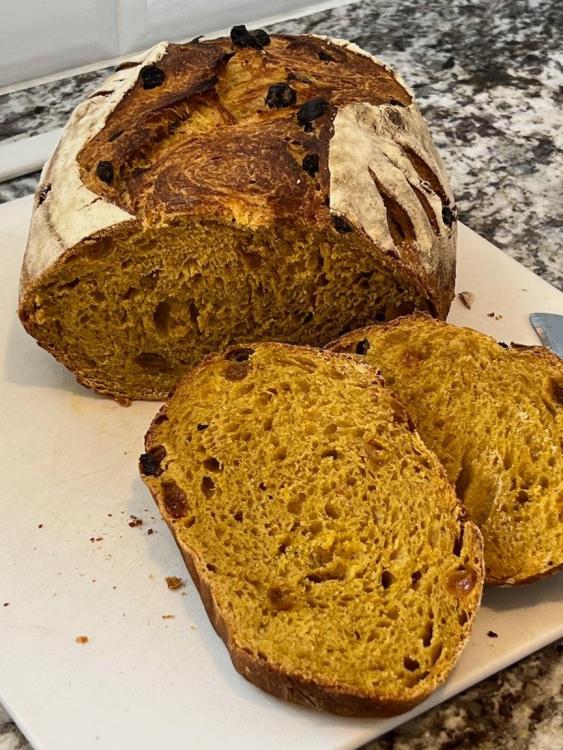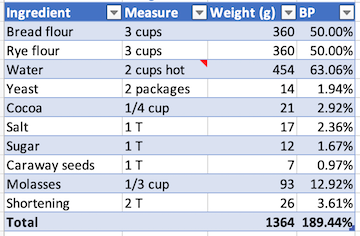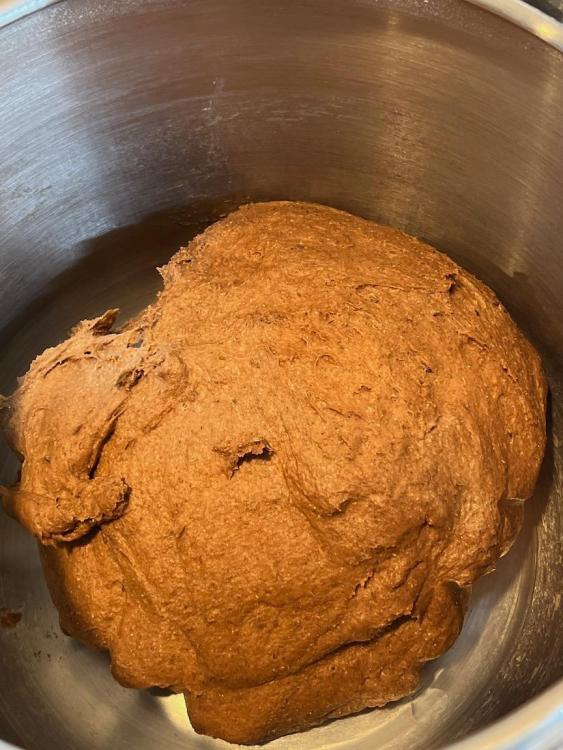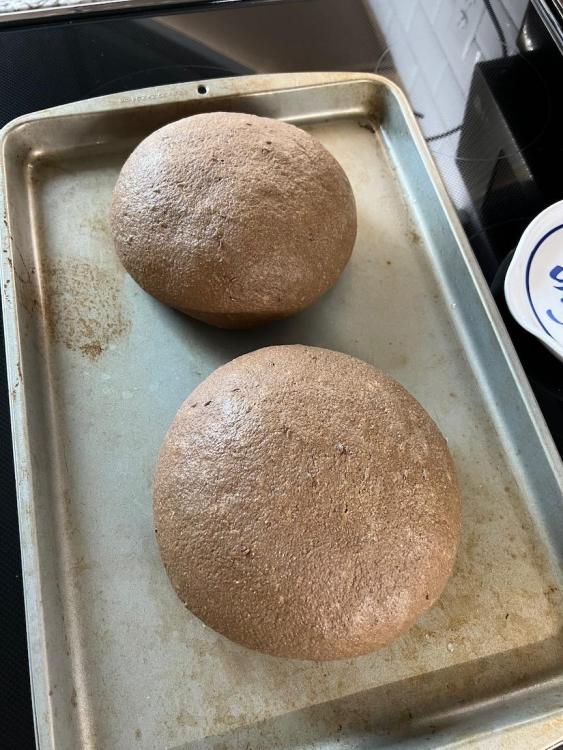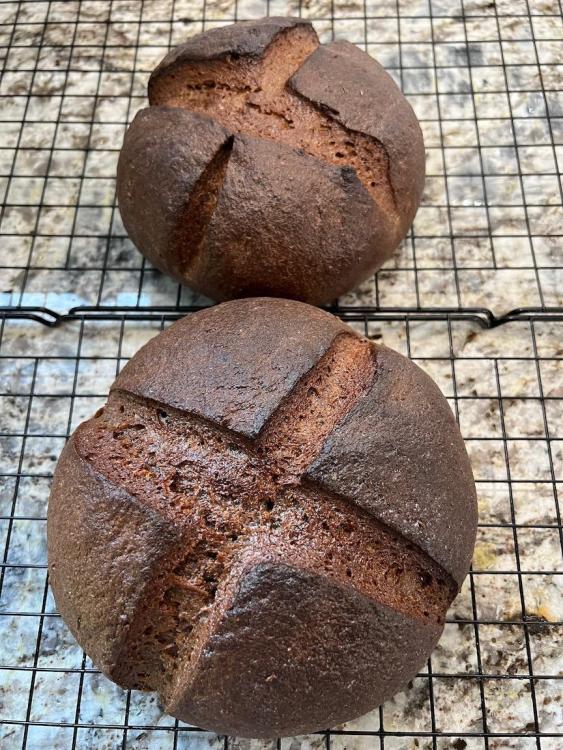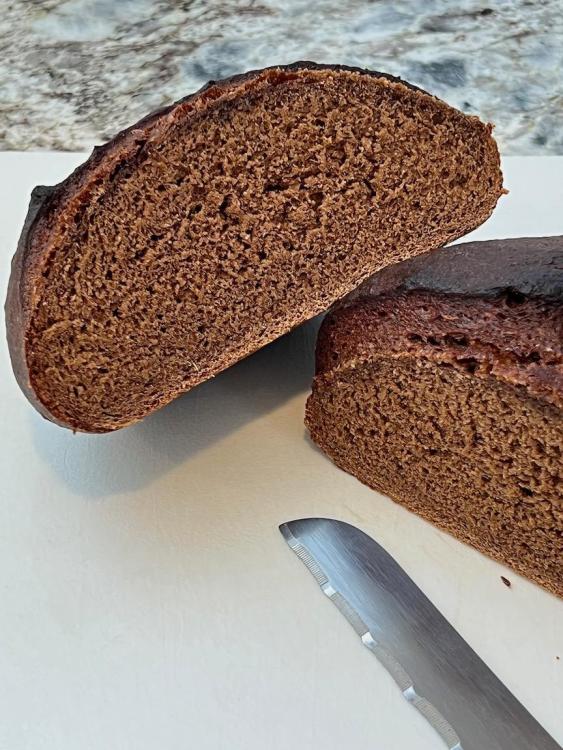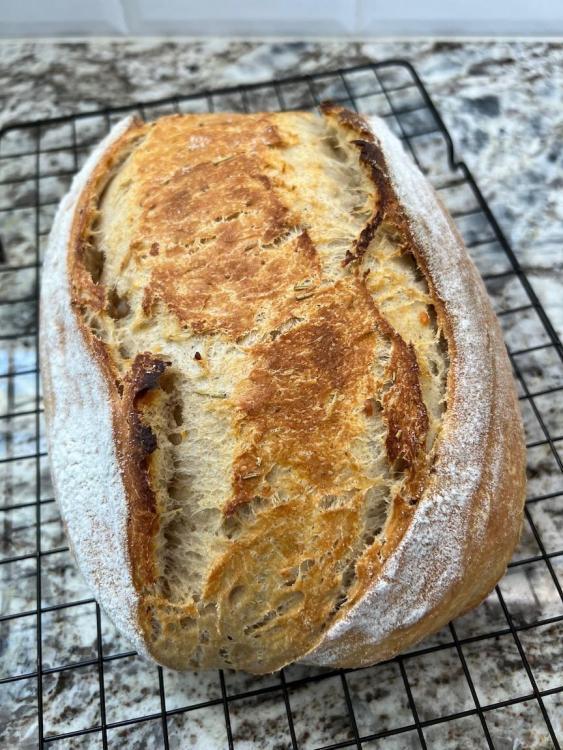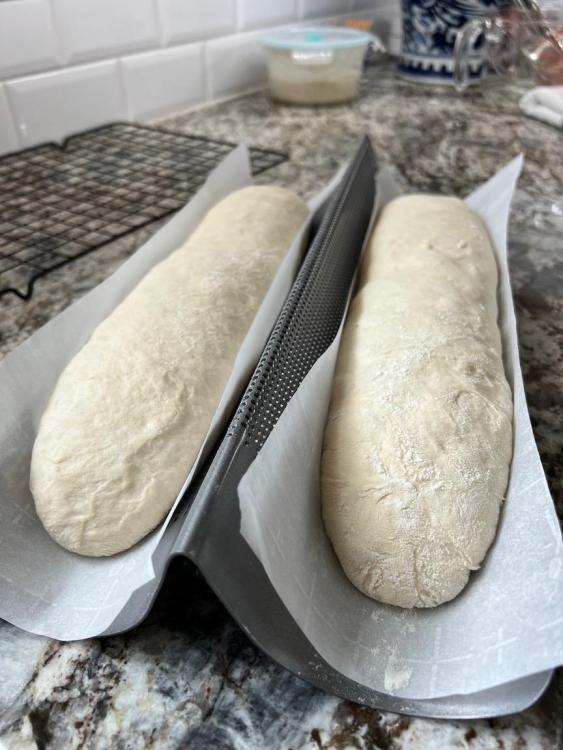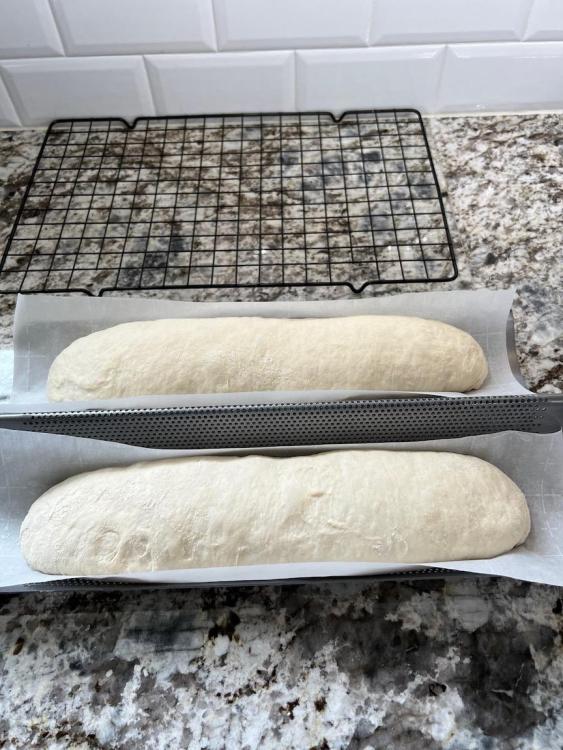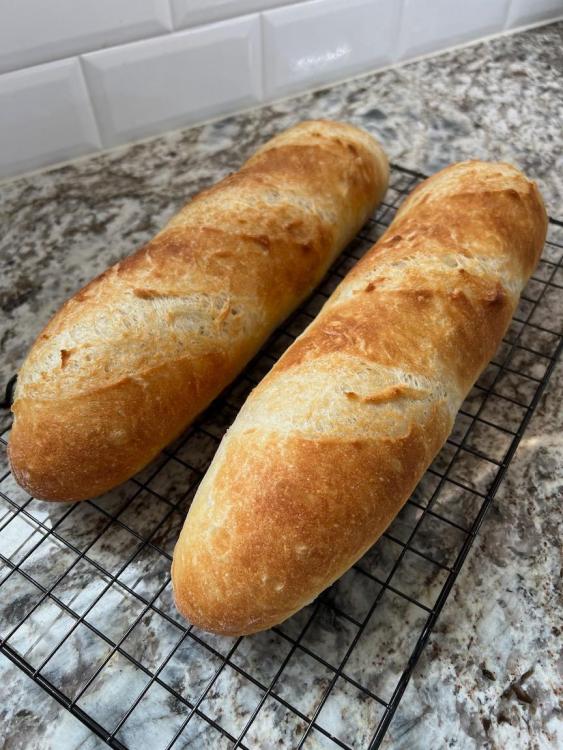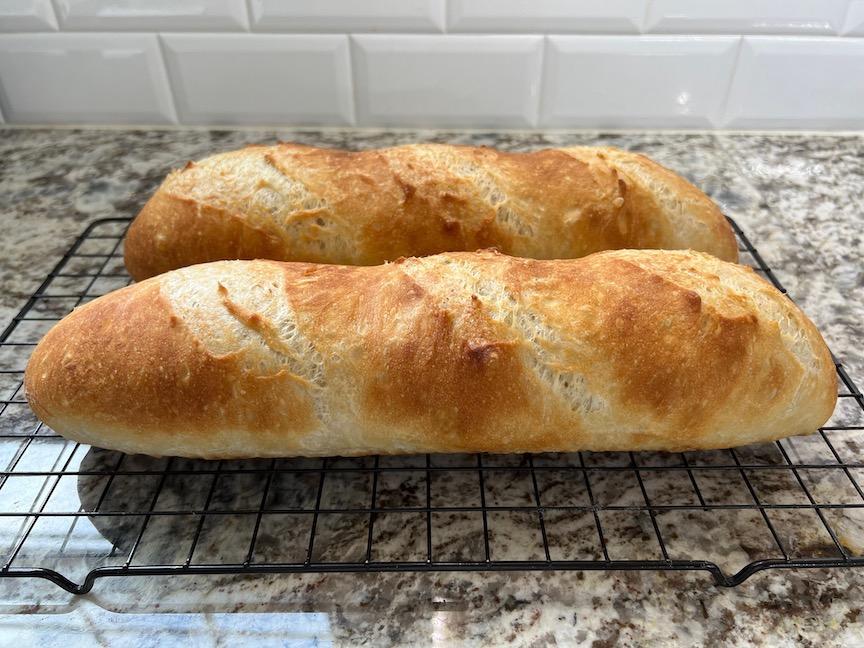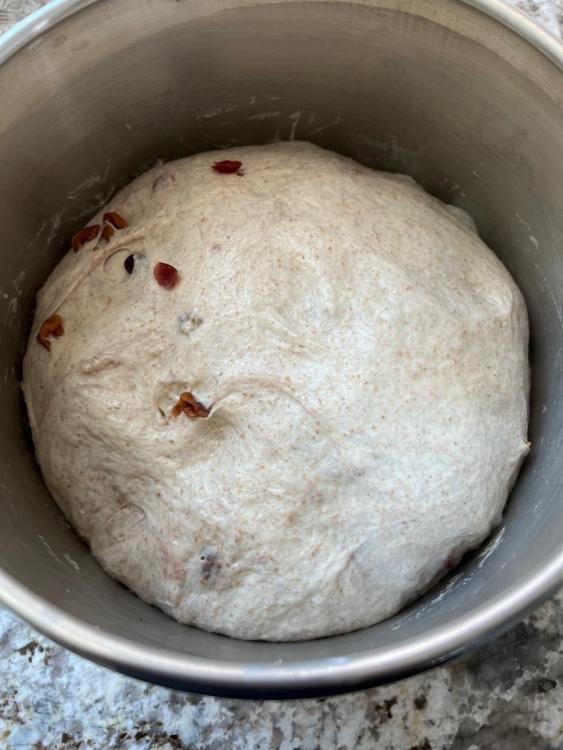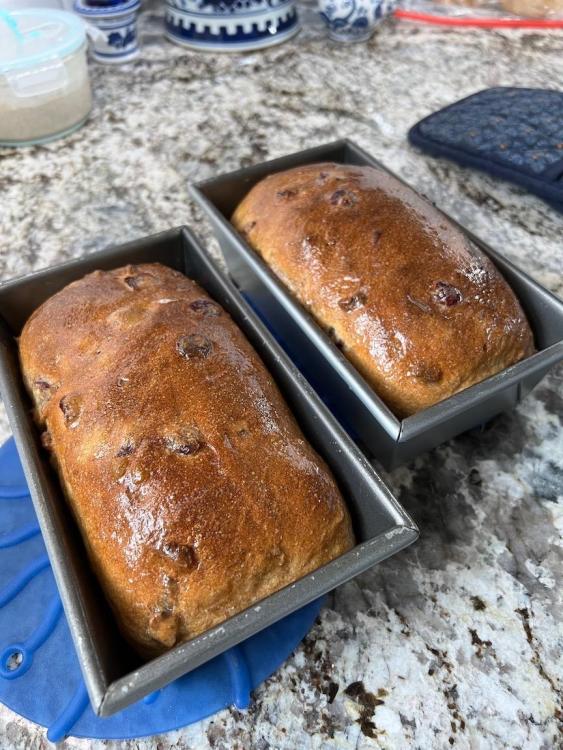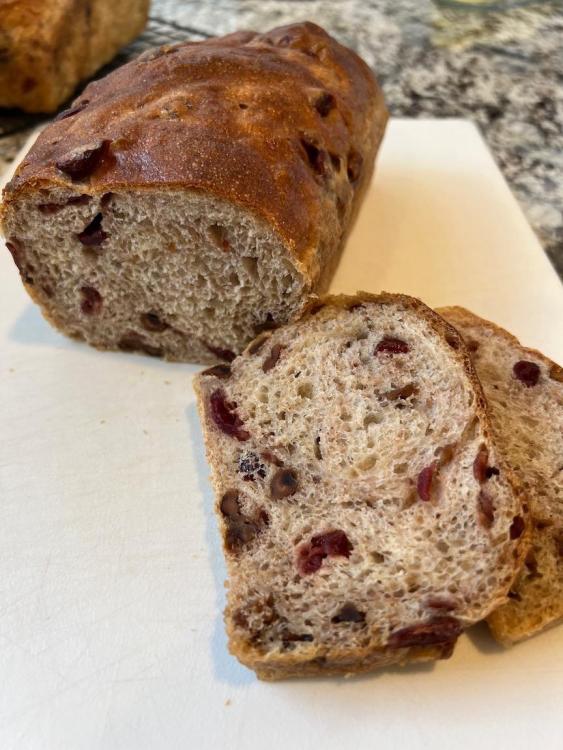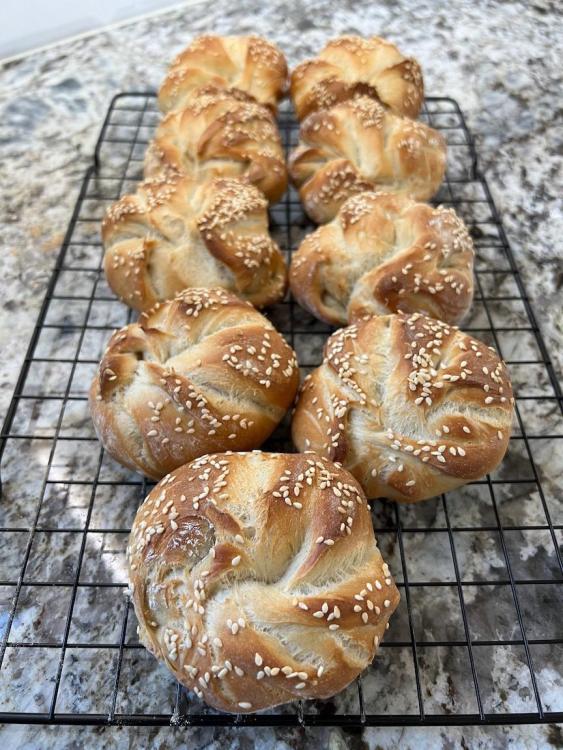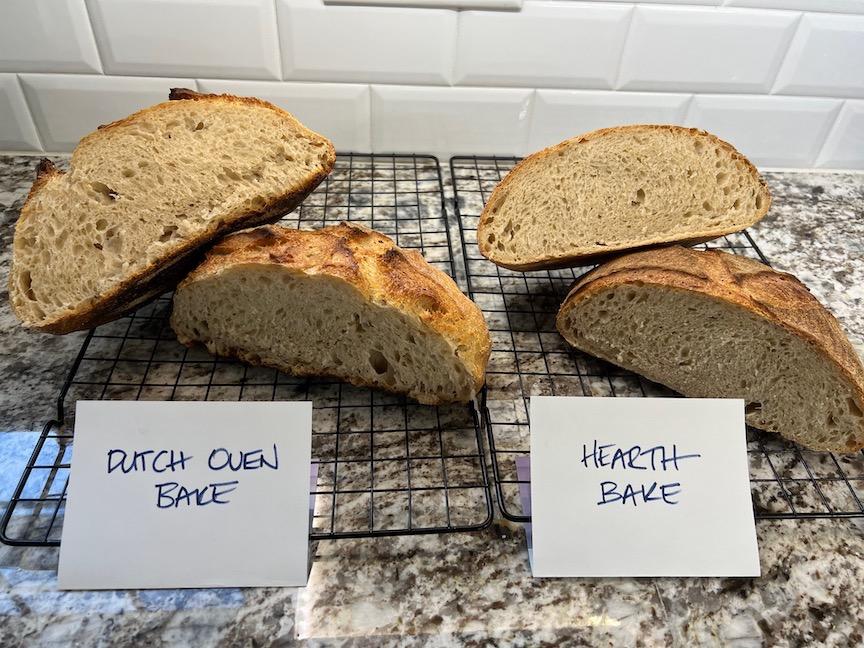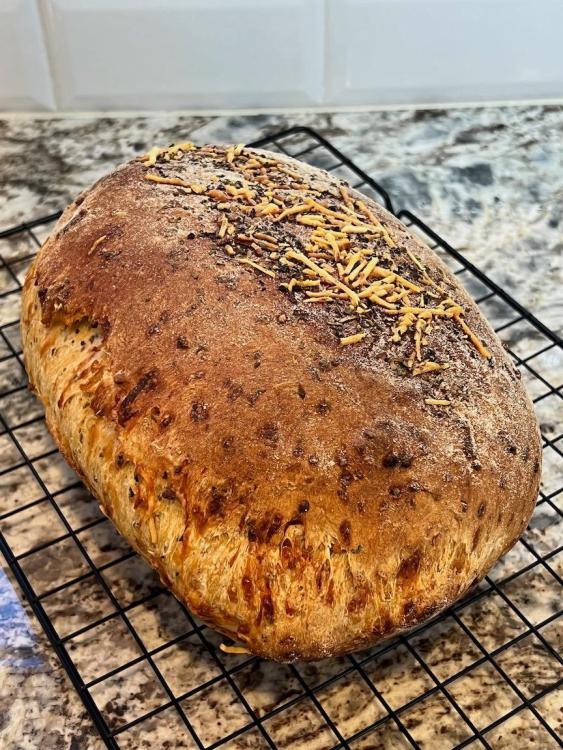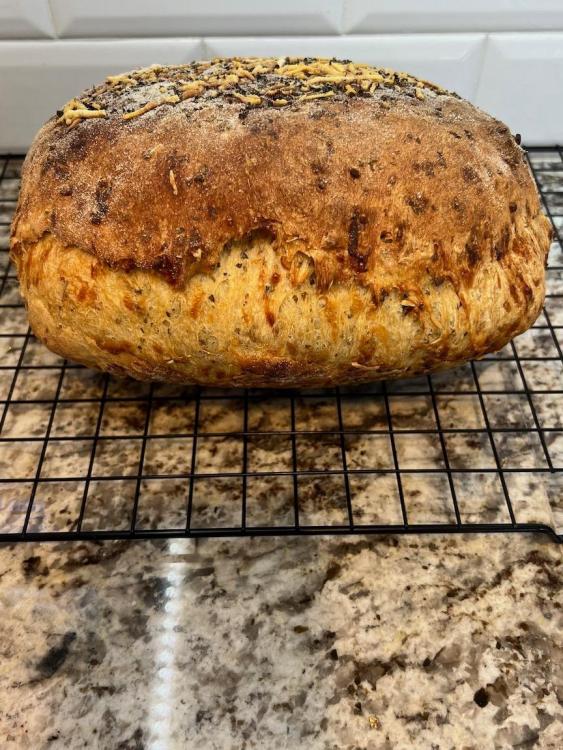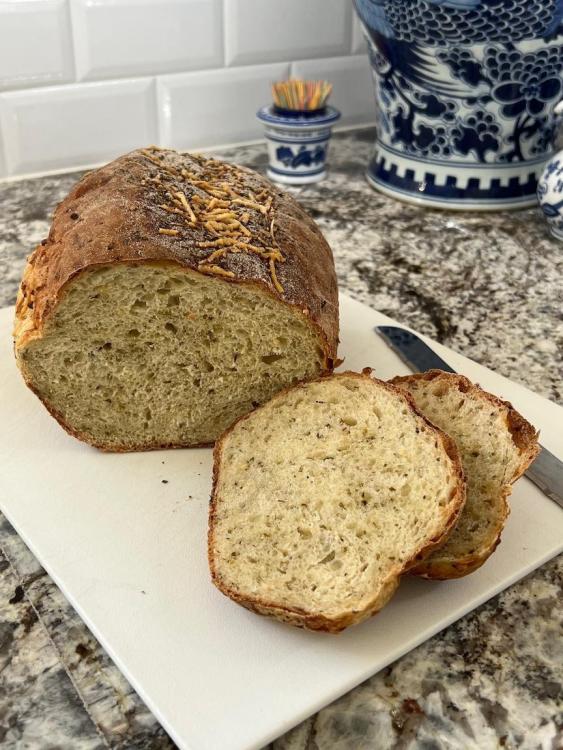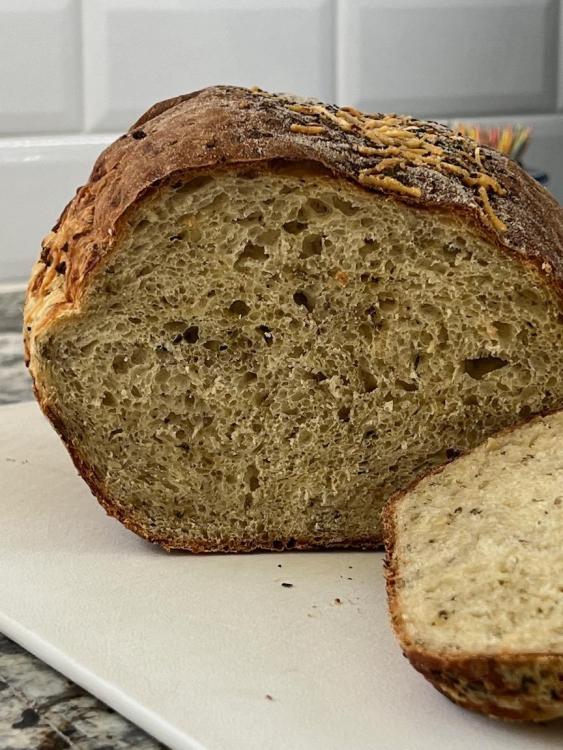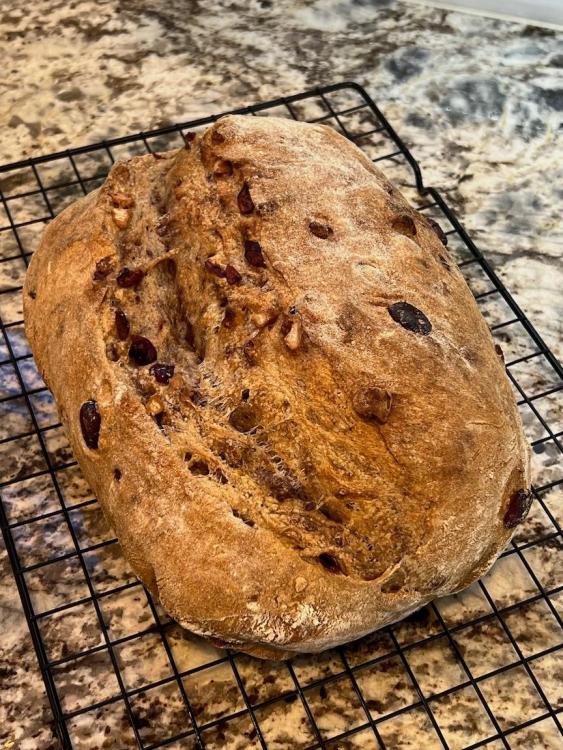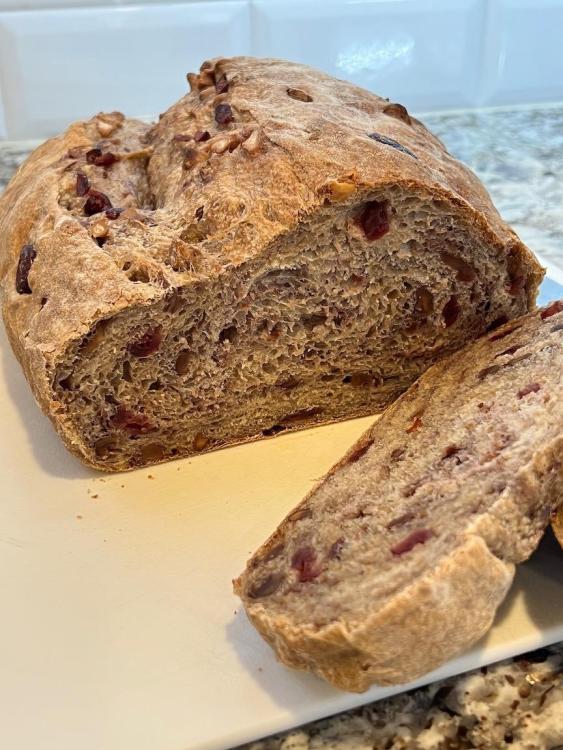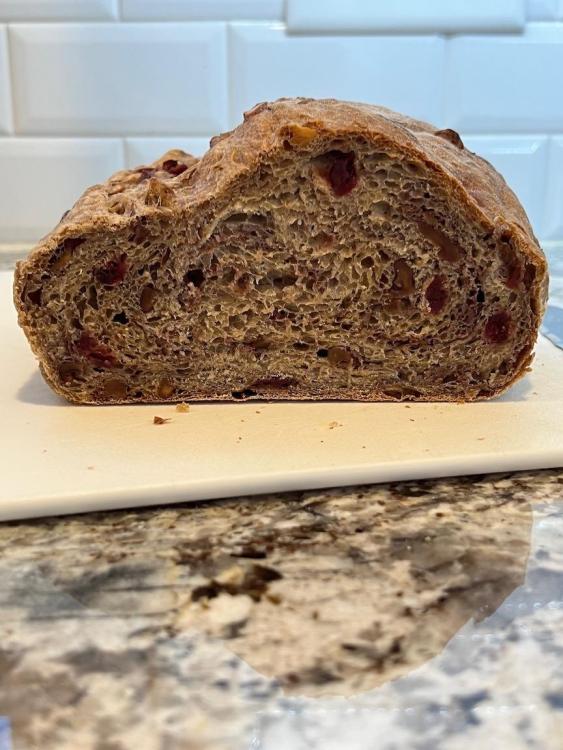-
Posts
396 -
Joined
-
Last visited
Content Type
Profiles
Forums
Store
Help Articles
Everything posted by PatrickT
-
Pumpkin cinnamon sourdough with raisins, courtesy of Maurizio at The Perfect Loaf. I substituted pumpkin pie spice for the cinnamon, as well as honey for the sugar in the dough. The aroma of this loaf baking was only surpassed by its subtle and lovely flavors. Very moist and tender crumb. This one is going to become a family favorite for sure!
-
I recently acquired a first edition of Bernard Clayton's The Complete Book of Breads and have really enjoyed browsing the many recipes he shared for all sorts of breads. His anecdotes about the recipes are fascinating and occasionally quite humorous. Being a lover of old cookbooks and recipes, I thought it would be fun to try some of them out. Here's my first attempt - his recipe for Heidelberg Rye, which calls for a 12-24 hr cold fermentation. This was really fun to make - so incredibly simple, with a very unique flavor and texture. Excellent as both bread and toast, with a hearty rye flavor. The cocoa and molasses give it a lovely sweet note, with barely a hint of chocolate. My conversions for it appear below, in case anyone would like to give it a try.
-
Cheddar, rosemary and roasted garlic sourdough. Certainly one of the finest smelling loaves I've baked thus far!
-
@Ann_T Not even in the same galaxy as your epic specimens, but I'm reasonably happy with these baguettes, baked today for our neighbor using your recipe and process. My only deviation was trying a baguette pan for the final proof and bake instead of the stone - and I'm pleased with the results. Next time, I'm going to try working in a refrigeration step prior to baking to help firm up the dough to make scoring a little easier. Thank you again for sharing this with us! 🙏
-
Our (adult) kids will love that! Thank you for suggesting. 👍
-
Cranberry Walnut bread v3.0 - baked in bread pans this time, along with a couple of additional tweaks. Getting closer. 🙂
-
Thank you @Ann_T! It was really delicious. Will definitely bake that again. That glistening crumb on all of your loaves is truly next level. Fantastique! 😃
-
Many thanks, Dave!
-
-
“Baking is a relaxed art. There is no step in the bread-making process that cannot, in some way, be delayed or moved ahead just a bit to make it more convenient to fit it into a busy schedule. If you are called away overnight just when the dough is rising in the pans, oil the dough surfaces, cover with plastic wrap and slip the pans into the refrigerator to keep until you return. If the dough you are shaping gets stubborn, pulls back and refuses to be shaped, walk away from it for a few minutes. It will relax, and so will you. … There are two other questions often asked which will give heart to anyone considering the first loaf. ‘How can anything so delicious be so easy to make?’ and ‘Why didn’t I do this before?’” — The Breads of France, by Bernard Clayton, Jr., 1978.
-
Our son wants me to bake him a loaf of that cranberry walnut bread, so I'll divide the dough in two and give that a try. Great idea - thanks!
-
@Dave R THOSE LOAVES! 😍 Seriously, the consistency you've been able to achieve in your many years of baking is quite extraordinary, Dave. Holy wow. Beautiful! See - THIS is my thing with the hearth baking! If I had access to a 500 degree commercial oven with the "blast of steam" option, it would be one thing. But trying to recreate that in my dinky LG oven? Hmm. Is that really necessary? And from the appearance of the bread you turn out, I would say emphatically not! And I do really love that about baking in some sort of covered vessel. That Challenger pan looks very interesting in that regard for both boules and batards - but I'm a bit gun shy to try that, based on the issues I alluded to above with my Dutch oven. And I'm on a fixed income now, so cheap has never looked so alluring! 🤣 Thank you! Very helpful. So I know I've experienced this but didn't understand the reasoning behind it. I get it now! Thank you for sharing this! Thank you! How about if I post my proposed formula and time table here before I try it out and you can let me know what you think? Thank you so much, Dave. I appreciate you!
-
@rotuts So kind of you - thank you! Love these questions - thanks for asking! I am such a kook with this - I've just found bread making to be surprisingly (and endlessly and delightfully) fascinating, which has proven to be a very rewarding retirement project. LOL My wife thinks I'm crazy (but thankfully, she loves bread, so... 😉 ). I have spreadsheets of recipes, baker's percentage templates and "variable tests" I'd like to run - the first of which was the test above. I made notes! 😂 Here were my thoughts: Internal temp of both loaves upon removal was surprisingly 208 degrees on the nose. Visually/aesthetically, I found the vessel bake loaf overall to be more to my liking (with the exception noted below). Crust color for the hearth baked bread was definitely more mahogany in color (hard to tell in the pic above); crust color for the vessel bake was more of a deep golden brown. Bottom color for the hearth bake was perfect - nicely browned; bottom color for the vessel bake (it was an enameled dutch oven) was extremely dark brown... nearly black. Side note: So far, I've been unable to solve this problem - the bottom is always darker and tougher than I want it to be when I use the enameled dutch oven. Not so for the Pampered Chef and Romertopf vessels I have. Nor do I ever have that problem when baking on the stone. I've tried lining the dutch oven with parchment, lining it with foil AND parchment, placing an empty baking sheet on the rack immediately below it, lining the dutch oven with a silpat - nothing seems to give me a consistent result that's not overly dark. Our oven is newer and doesn't have a visible heating element at the bottom of the oven, but I did wonder if raising or lowering the rack might help (it's on the middle rack right now). I described the crust on the hearth bake as "crisp and leathery," while the vessel bake was "crisp and crunchy." I found the flavor of the hearth bake to be "tangy" (these were sourdough loaves) and the vessel bake to be "mild." That said, both were delicious! Such a great question. For me, there is nothing like a fresh crust that literally crunches in your hands as you cut it and as you bite into it. I always marvel at that! So sad that our baked loaves move so quickly beyond that point. That said, toast is divine and restores a lot of that initial crunch factor for me... all the way to the end of the loaf. Toast deserves more credit! LOL For these loaves, I preferred the vessel bake fresh because the crust was SO crunchy, but both were delightful as toast. Exactly why I wanted to try this little experiment. I do admittedly love the ease and allure of plopping my dough into something, covering it, baking it, and just having it come out perfect every time. The reality hasn't proven quite that simple, of course, and I think I'm not nearly as well versed in the hearth method yet - so I probably unfairly give it short shrift. I really want to give @Dave R's method a try and give myself time to become more adept with it. Hope that was helpful? Thanks for the great discussion! 🙂
-
@Dave R Thank you, sir! 😃 SO appreciative of your thoughtful response - thanks, Dave! Thanks! The next time I bake these, I'll try baking them on a stone. Do you always add steam when you bake bread? Or perhaps the better question - when should you add steam and when not? I don't have a CSO but have used the hearth method (baking stone with hot water in a pan at the bottom of the oven) with other loaves I've made. It's worked well for me but in a side by side experiment I did just a few weeks back, I felt that I got slightly more oven spring and a more open crumb from the vessel method than from the hearth method. Comparison photo below. The test was based on a single batch of dough divided in half, both baked at the same temperature and for the same amount of time. Very helpful and makes perfect sense - thank you! So really, any loaf baked on a stone (or in a vessel) should be scored to help direct/control expansion from the CO2 release. Fascinating! Where do you score pan loaves? On the top, as with non-pan loaves? Amazingly identical! Thank you for this! 🙏 I'm going to take a stab at using your process to make a yeasted version of my typical sourdough loaf and bake it on a stone. I'll post my results and you can see what you think. I'll have to modify the times a bit. Here I always thought I was an early riser at 0500! 😂 Thank you again for patiently answering my questions. I really appreciate it!
-
You should write a cookbook with some of these ideas! 🤣 Awesome - thanks!
-
Well - we had one but found we didn’t use it as often as we thought we would, so we donated it to our daughter. She loves it and uses it all the time. Probably should have given it more of an effort. This is a great use for one - might have to watch for another one at our local garage and estate sales! Thanks for the great tip! 👌
-
After my earlier bake this week of Cranberry Walnut bread, I found myself in the mood for something savory to accompany a batch of homemade chicken noodle soup I made. Speaking of which, am I the only fool who freezes leftover rotisserie chicken carcasses to make their own chicken stock? Apologies - I digress. 🙂 Anyway... I consequently revisited the recipe I tried for my very first bread bake back in December of last year - a Parmesan Garlic Herb loaf. The rather oddly shaped result owes itself to the Romertopf I baked it in, but the taste is just wonderful. Comparing this loaf to the pictures I took of my first effort, I was pleased to see that I was able to produce a much better rise and darker crust color this time around. @Dave R - I used ChainBaker's method of batard shaping for this loaf and I think it really helped the loaf hold its shape during baking. My last two bakes have prompted a question about scoring loaves. How do you know when a loaf should be scored for baking or not? If you look at the Cranberry Walnut bread I baked earlier in the week, I scored that loaf and baked it in a covered baking dish. The result appears to have expanded along the score, but aesthetically, it's not terribly pleasing. There is no real "ear" nor really crisp crust development. This was a yeasted recipe but it also included mixed grains, as many of my sourdough loaves do. I essentially baked them the same way but the sourdough loaves produce a much more pleasing end result. Was scoring the Cranberry Walnut loaf to blame? Should it have been baked in a pan, rather than in a covered baking dish? With this bake, I decided to NOT score the loaf - but looking at it from the side, it clearly "split." In retrospect, it seems like I should have scored it, but what would lead me to know that in advance? I apologize if these are stupid questions. I'm beginning to think about enjoyment that would come from creating my own bread recipe formulas, but I feel stymied by when to use some of the techniques I've learned (e.g., scoring, baking in a cloche, stretching and folding dough to add structure, cold proofing in the refrigerator to enhance the flavor, etc.). Any insights or comments would be most welcome. Thank you for putting up with me! 😂
-
I have got to try those! Was it Chainbaker’s recipe?
-
That looks stunning @Dave R!! Wow!
-
Thank you @Dave R! I do feel that my "pre-shape, rest, final shape" process is becoming more consistent, with @Ann_T's baguettes as the likely outlier. 😂 I must say - I'm becoming increasingly fond of the "eating your experiments" part of this bread making process! Appreciate your feedback as always, Dave. Cheers!
-
Well - it's definitely not the most beautiful loaf I've ever baked, but this is definitely closer in texture and flavor to the bread we used to love at a local restaurant that has long since closed. A few thoughts, based on our taste testing (the toast test will come tomorrow morning 😉 Very soft and chewy - crust is perhaps too soft My wife felt there should be more craisins and fewer walnuts (the recipe I used called for 85g of each) Craisins were deliciously sweet as a result of the rum soak - but the fancy rum didn't add anything appreciable, so I would just use regular rum next time Overall, just the right amount of sweetness, I think This dough could easily make two pan loaves - and I think I might try that next time Would love to hear any other feedback or critiques any of you might have. Thank you!
-
@heidih This is a great insight and something I’ve wondered about as a newbie bread maker. Will definitely keep this in mind for future. Thank you!
-
Thank you! FoodGeek has a really interesting cranberry walnut sourdough recipe with bourbon soaked craisins. 😍 I wanted to try a yeasted version for my loaf this time around, so I adapted his recipe for that. I also have an amazing sipping rum on hand, so I decided to go with that. The aroma of the proofing dough is just heavenly - can’t wait to see how it turns out! I’ll keep you posted. 👍
-
@Ann_T Agree with @Dave R - gorgeous loaves as always! I really appreciated seeing these, Dave. I'm using this technique with almost every loaf of bread I make now. More than anything, it's really helped me develop a feel for the way dough changes as it develops. I actually just showed this process to my wife this morning (working on v2.0 of the cranberry walnut bread I posted earlier). She's a ridiculously good baker - but has never tried making bread before. She was really fascinated by it. I may have to brace myself for some spousal competition! 😂
-
Fantastic idea @Smithy - those look positively beautiful! Definitely going to give those a whirl next time I make this recipe. Thank you! Smart girl! And probably the perfect name for it, honestly. 😉



